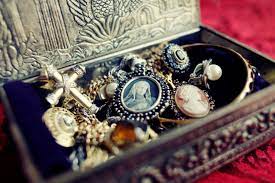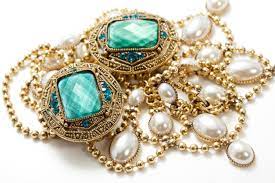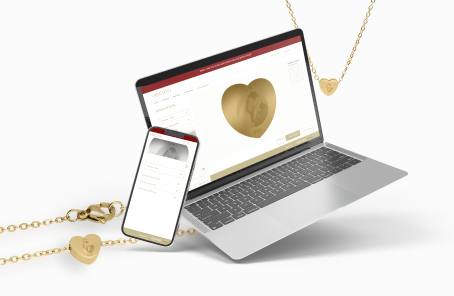Antique and vintage jewelry holds a unique fascination. These one-of-a-kind pieces tell stories from bygone eras and often showcase exceptional craftsmanship.
In this article, we’ll explore the various aspects of antique and vintage jewelry, from eras and styles to materials and care. Discover why these pieces are more than just accessories and what significance they hold today.
Table of Contents
- Definition and Distinction between Antique and Vintage Jewelry
- Popular Eras and Styles
- Materials and Techniques
- Valuation and Authentication
- Care and Storage
- Why Antique Jewelry is a Sustainable Choice
- Tips for Buying Antique and Vintage Jewelry
- Conclusion
- Frequently Asked Questions
Definition and Distinction between Antique and Vintage Jewelry
Antique jewelry is generally over 100 years old and originates from eras such as the Victorian era, Belle Époque, or Art Deco. Vintage jewelry, on the other hand, encompasses pieces that are at least 20 years old but less than 100 years and can date from various decades of the 20th century. The main difference lies in the age of the pieces.
Popular Eras and Styles
Each era has its own distinctive styles and techniques:
- Victorian Era (1837-1901): Romantic designs with symbols of love and loss, often featuring gemstones like garnet and amethyst.
- Belle Époque (1871-1914): Delicate and elegant pieces with pearls and diamonds, often set in platinum.
- Art Deco (1920-1935): Geometric shapes and bold colors, frequently with gemstones such as onyx, jade, and coral.
- Mid-Century Modern (1940-1960): Simple yet elegant designs with a focus on clean lines and high-quality materials.
Materials and Techniques
Antique and vintage jewelry is characterized by the use of high-quality materials and handcrafted techniques:
- Precious metals: Gold, silver, platinum, and sometimes palladium.
- Gemstones: Diamonds, rubies, sapphires, emeralds, and organic materials like pearls and coral.
- Techniques: Hand engraving, enameling, millefiori (fine bead borders), and intricate stone settings.
Valuation and Authentication
Authenticating and valuing antique jewelry requires expertise:
- Certificates of Authenticity: Many reputable dealers provide certificates confirming the authenticity and quality of the jewelry.
- Hallmarks and markings: These provide information about the age, origin, and material quality of the piece.
- Condition: The state of preservation significantly influences value. Slight wear is normal for antique pieces and often adds to their charm.
Care and Storage
Proper care is essential to preserve the beauty and value of antique jewelry:
- Cleaning: Use mild soap and warm water. Avoid harsh chemicals.
- Storage: Store pieces separately in soft cloths or jewelry boxes to prevent scratches.
- Professional maintenance: Have valuable pieces inspected and cleaned regularly by a professional jeweler.
Why Antique Jewelry is a Sustainable Choice
Antique jewelry is sustainable as it is recycled and reused, reducing the consumption of new resources.
Purchasing antique jewelry often supports small, specialized dealers and helps preserve traditional craftsmanship. This makes antique jewelry an environmentally friendly and ethical choice.
Tips for Buying Antique and Vintage Jewelry
When buying antique jewelry, consider these tips:
- Research: Educate yourself about different eras and styles.
- Trustworthy dealers: Purchase from reputable dealers who offer certificates of authenticity.
- Check the condition: Look for signs of wear and inquire about the piece’s history.
- Compare prices: Research current market values to ensure fair pricing.
Conclusion
Antique and vintage jewelry offers more than just aesthetic appeal; it provides a tangible connection to the past. The unique designs and exceptional craftsmanship make these pieces valuable heirlooms and sustainable fashion accessories.
With proper care and knowledge, you can enjoy the beauty and history of antique jewelry for years to come.
Engraved jewelry, as Unique as You
Thanks to your creativity and our jewelry configurator, you can create a personalized piece with just as special as you.
Here’s how to turn your favorite design into a lasting memory:
- Find Your Perfect Piece: Browse our collection and choose the necklace or bracelet that best suits his style.
- Pick Your Design: Choose among all the design options. It can be a picture, a message, or anything you’d like!!
- We Do the Magic: Our whiz-bang tech transforms your design into a high-quality engraving. No need to worry about fancy editing skills, we’ve got it covered.
- See It Before You Get It: Before we engrave your masterpiece, you’ll get a preview to make sure everything looks perfect.
Every set of engraved jewelry tells a unique story, a personal narrative close to the wearer’s heart.

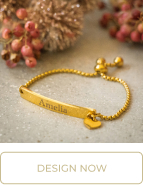


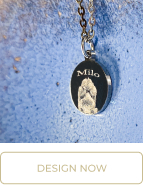

Frequently Asked Questions (FAQs)
- What is the difference between antique and vintage jewelry? Antique jewelry is over 100 years old, while vintage jewelry is typically 20 to 100 years old.
- How can I identify authentic antique jewelry? Look for hallmarks, certificates of authenticity, and examine the piece for signs of age and craftsmanship.
- Which eras are most popular for antique jewelry? The Victorian, Belle Époque, Art Deco, and Mid-Century Modern eras are particularly sought after.
- How should I care for antique jewelry? Handle with care, use mild cleaning agents, and store in soft pouches or boxes to prevent damage.
- Why is antique jewelry considered sustainable? Antique jewelry promotes recycling and supports traditional craftsmanship.
- Where can I buy antique jewelry? Reputable antique stores, online platforms, and specialized jewelry dealers are good options.
- What materials are commonly used in antique jewelry? Gold, silver, platinum, diamonds, pearls, and other gemstones are common materials.
- How do I determine the value of antique jewelry? Factors such as age, condition, materials, and provenance influence the value. Consult a professional appraiser for accurate valuation.
- What are hallmarks and why are they important? Hallmarks are markings on jewelry that indicate the metal content, maker, and sometimes the date of manufacture.
- Can I wear antique jewelry daily? While possible, consider the delicacy of the piece and avoid exposing it to harsh conditions.
- What are current trends in vintage jewelry? Art Deco and Mid-Century Modern styles are popular, but there’s a growing appreciation for all vintage eras.
- How can I spot a fake antique piece? Lack of hallmarks, poor craftsmanship, and inconsistent styles can indicate a fake. Consult an expert if unsure.
- What gemstones are commonly found in antique jewelry? Diamonds, rubies, sapphires, emeralds, pearls, and other semi-precious stones are frequently used.
- How should I store antique jewelry? Store each piece individually in soft pouches or fabric-lined boxes to prevent scratches and damage.
- Can antique jewelry be repaired or restored? Yes, but it’s essential to find a skilled jeweler experienced in working with antique pieces.
